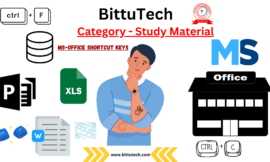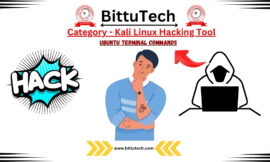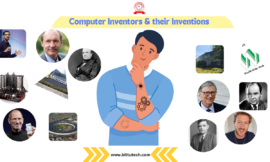Introduction
Table of Contents
Hello techies!! We are here again with one of the most interesting Topic of Technical World. First of all I wanna to Welcome you all on this domain bittutech.com — Your Learning Hub.
So without getting too late, Let’s dive in the TECHNICAL WORLD once again…
In the rapidly evolving landscape of the 21st century, technology has become the cornerstone of modern civilization. It has permeated every aspect of our lives, from how we communicate and conduct business to how we learn, heal, and innovate. The digital world is not just a parallel universe; it is the environment in which much of our daily activity takes place. As we continue to embrace this transformation, technology solutions are becoming indispensable in helping us adapt, grow, and lead in this interconnected era.
This blog explores the major technology solutions and how individuals, businesses, and governments can harness their potential to shape a better future.
Cloud Computing: The Backbone of Digital Infrastructure
Cloud computing has revolutionized the way data is stored, accessed, and shared. By offering scalable, on-demand computing resources over the internet, cloud platforms eliminate the need for costly on-site hardware and infrastructure. Businesses can now launch applications, store vast amounts of data, and collaborate across continents with just a few clicks.
Key benefits of Cloud Computing include:
- Cost efficiency: Pay-as-you-go models reduce capital expenditure.
- Scalability: Easily adjust resources based on demand.
- Accessibility: Access data and applications from anywhere with an internet connection.
- Business continuity: Cloud-based backups ensure data is safe during disruptions.
Major providers like Amazon Web Services (AWS), Microsoft Azure, and Google Cloud have become vital enablers of digital transformation for enterprises of all sizes.
Artificial Intelligence and Machine Learning: Intelligence That Learns and Adapts
AI and ML are no longer science fiction; they are real, practical tools enhancing productivity, personalization, and decision-making. From virtual assistants like Siri and Alexa to complex algorithms that detect financial fraud, AI is reshaping how services are delivered and optimized.
Some key applications include:
- Predictive analytics: Anticipate customer behavior, market trends, or equipment failures.
- Natural language processing: Enhance customer support with chatbots and voice assistants.
- Personalization: Tailor recommendations in e-commerce, entertainment, and education.
- Automation: Streamline repetitive tasks, reducing human error and increasing efficiency.
As these systems learn from data over time, they continuously improve their accuracy and effectiveness, making them powerful tools in the digital world.
Cyber Security: Protecting the Digital Frontier
With the increasing reliance on digital platforms comes heightened vulnerability to cyber threats. From data breaches to ransomware attacks, the risks are real and potentially devastating.
Modern Cyber Security solutions include:
- AI-powered threat detection systems.
- Multi-factor authentication.
- Blockchain for secure data transactions.
- Endpoint protection for mobile and IoT devices.
A strong cybersecurity posture is essential not only for protecting sensitive data but also for maintaining customer trust and regulatory compliance.
Internet of Things (IoT): Connecting the Physical and Digital Worlds
IoT is the network of physical devices—ranging from household appliances to industrial machines—that are embedded with sensors and connected to the internet. These smart devices collect and exchange data to optimize performance and improve decision-making.
IoT is transforming industries:
- In healthcare, wearable devices monitor patient vitals in real-time.
- In agriculture, sensors track soil conditions and weather patterns.
- In manufacturing, IoT enables predictive maintenance and automation.
- In cities, smart grids and traffic systems reduce waste and enhance efficiency.
The data generated by IoT devices feeds into analytics platforms, creating a feedback loop that enables smarter systems and services.
5G and Edge Computing: Speed and Proximity Redefined
5G networks are redefining connectivity with ultra-fast speeds, low latency, and high capacity. When combined with edge computing—which processes data closer to its source rather than in a centralized data center—5G opens the door to real-time applications that were previously impractical.
Use cases include:
- Autonomous vehicles communicating with their environment.
- Augmented and virtual reality experiences in education and entertainment.
- Real-time monitoring and control in industrial automation.
- Telemedicine services with high-definition video and low latency.
Together, 5G and edge computing are setting the stage for innovations that demand both speed and responsiveness.
Blockchain: Trust in a Trustless Environment
Blockchain technology is a decentralized ledger system that ensures transparency, immutability, and security in digital transactions. Originally developed for cryptocurrencies, its potential spans across various industries.
Applications include:
- Supply chain management: Ensuring provenance and authenticity of goods.
- Healthcare: Securing patient records and improving interoperability.
- Finance: Reducing fraud and improving transaction efficiency.
- Governance: Enabling secure digital voting and identity verification.
By removing the need for centralized intermediaries, blockchain increases trust and accountability in digital interactions.
Digital Literacy and Ethical Considerations
Technology is only as effective as the people using it. Digital literacy—the ability to understand and engage with technology—is crucial for empowering individuals in the digital age. Moreover, as we deploy increasingly powerful tools, ethical questions around privacy, bias, and access must be addressed.
Key areas to consider:
- Ensuring equitable access to technology.
- Mitigating algorithmic bias and ensuring transparency.
- Protecting personal data and upholding digital rights.
A responsible approach to technology fosters a more inclusive, fair, and sustainable digital ecosystem.
Conclusion
The digital world is a dynamic, ever-changing environment. Technology solutions are not just tools; they are enablers of progress, connection, and transformation. By embracing innovations such as cloud computing, AI, IoT, and cybersecurity, we can build a digital future that is efficient, inclusive, and secure.
As we continue to navigate this era of digital transformation, let us not only adopt these technologies but do so with purpose, responsibility, and a vision for creating positive change in our interconnected world.
Ready to transform your digital strategy? Embrace the future with smart technology solutions today.




